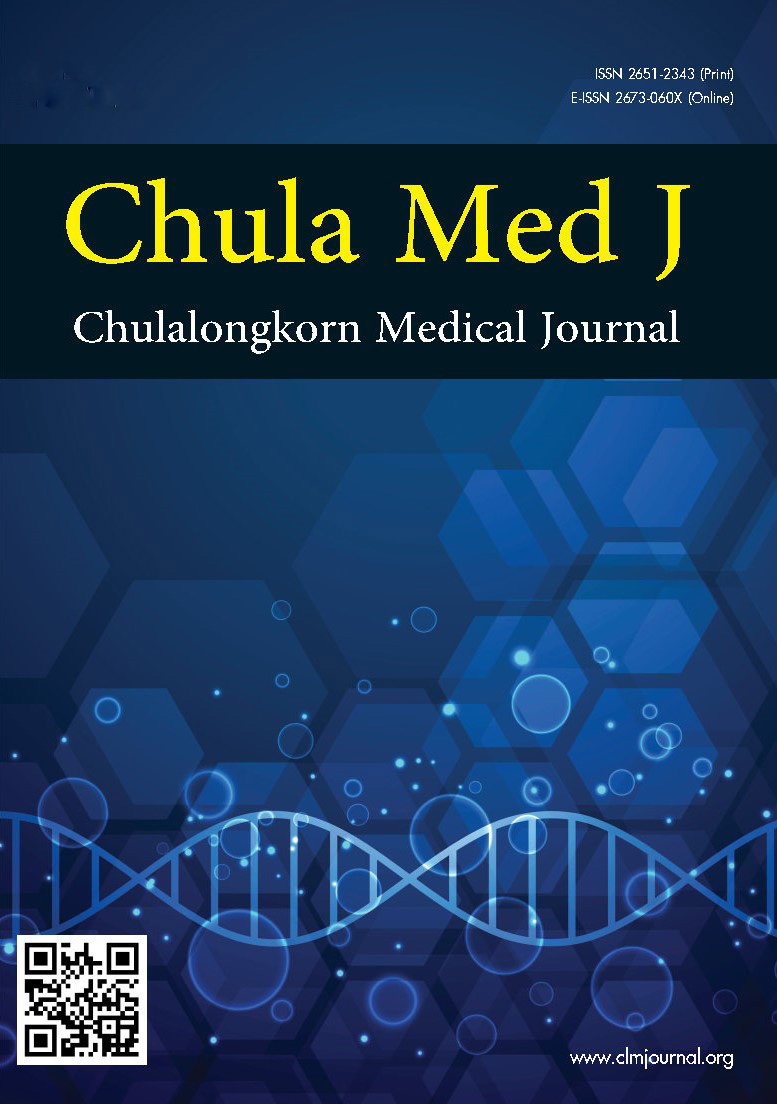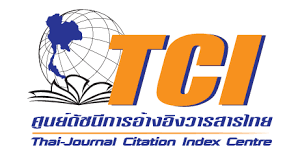Reliability and validation of the Thai version of the cosmetic procedure screening (COPS) questionnaire in Thai women
Keywords:
Body dysmorphic syndrome, cosmetic procedure screening, ThaiAbstract
Background: Body dysmorphic syndrome (BDD) is a psychiatric disorder characterized by dissatisfaction with and disapproval of cosmetic surgery outcome.
Objective: The aim of this study was to study the reliability and validate the Thai version of the cosmetic procedure screening (COPS) questionnaire.
Methods: Fifty-six Thai women attending the gynecologic outpatient clinic at King Chulalongkorn Memorial Hospital were recruited into the study between July 2017 and June 2018. Four participants dropped out because they did not answer the second questionnaire. The original English-version of COPS was translated into the Thai version and back-translated by another linguist. The content of the questionnaire was validated by two urogynecologists. After signing their informed consent forms, the patients were asked to complete the Thai version of the COPS questionnaire at first visit. Thereafter, at two-week intervals they completed and sent back the questionnaires by mail.
Results: The average age of participants was 34.1 + 6.4 years. The correlation coefficient of each item (Q) score with the total score of the Thai version COPS questionnaire ranged from 0.17 to 0.74. The internal consistency (Cronbach’s alpha) of the questionnaire was 0.9. The weighted Kappa of each score ranged from 0.6–1.0. The mean total scores of the 1st and 2nd assessments (points) were 22.9 + 8.7 and 23.9 + 8.0. The intraclass correlation coefficient (ICC) (95% confidence interval (CI)) of the total score was 0.9 (0.9–1.0).
Conclusion: The findings of this study indicate that the Thai version of the COPS questionnaire is reliable and valid. It can be used for screening for BDD in Thai women before cosmetic surgery.
Downloads
References
Heidekrueger PI, Juran S, Ehrl D, Aung T, Tanna N, Broer PN. Global aesthetic surgery statistics: a closer look. J Plast Surg Hand Surg 2017;51:270-4.
https://doi.org/10.1080/2000656X.2016.1248842
Shaw D, Allen L, Chan C, Kives S, Popadiuk C, Robertson D, et al. Guideline No. 423: Female genital cosmetic surgery and procedures. J Obstet Gynaecol Can 2022;44:204-14.e1.
https://doi.org/10.1016/j.jogc.2021.11.001
Thomson DR, Thomson NEV, Southwick G. Screening for body dysmorphic disorder in plastic surgery patients. Aesthetic Plast Surg 2024:48:2738-43.
https://doi.org/10.1007/s00266-024-03959-6
Sweis IE, Spitz J, Barry DR Jr, Cohen M. A Review of body dysmorphic disorder in aesthetic surgery patients and the legal implications. Aesthetic Plast Surg 2017;41:949-54.
https://doi.org/10.1007/s00266-017-0819-x
Vahia VN. Diagnostic and statistical manual of mental disorders 5: A quick glance Indian. J Psychiatry 2013;55:220-3.
https://doi.org/10.4103/0019-5545.117131
Eastwood CA, Southern DA, Doktorchik C, Khair S, Cullen D, Boxill A, et al. Training and experience of coding with the World health organization's international classification of diseases, eleventh revision. Health Inf Manag 2023;52:92-100.
https://doi.org/10.1177/18333583211038633
Veale D, Gledhill LJ, Christodoulou P, Hodsoll J. Body dysmorphic disorder in different settings: A systematic review and estimated weighted prevalence. Body Image 2016;18:168-86.
https://doi.org/10.1016/j.bodyim.2016.07.003
Veale D, Ellison N, Werner TG, Dodhia R, Serfaty MA, Clarke A. Development of a cosmetic procedure screening questionnaire (COPS) for body dysmorphic disorder. J Plast Reconstr Aesthet Surg 2012;65:530-2.
https://doi.org/10.1016/j.bjps.2011.09.007
Bonett DG. Sample size requirements for estimating intraclass correlations with desired precision. Stat Med 2002;21:1331-5.
https://doi.org/10.1002/sim.1108
Phillips KA, Grant J, Siniscalchi J, Albertini RS. Surgical and nonpsychiatric medical treatment of patients with body dysmorphic disorder. Psychosomatics 2001;42:504-10.
https://doi.org/10.1176/appi.psy.42.6.504
Ishigooka J, Iwao M, Suzuki M, Fukuyama Y, Murasaki M, Miura S. Demographic features of patients seeking cosmetic surgery. Psychiatry Clin Neurosci 1998;52:283-7.
https://doi.org/10.1046/j.1440-1819.1998.00388.x
Vindigni V, Pavan C, Semenzin M, Granà S, Gambaro FM, Marini M, et al. The importance of recognizing body dysmorphic disorder in cosmetic surgery patients: Do our patients need a preoperative psychiatric evaluation? Eur J Plast Surg 2002;25:305-8.
https://doi.org/10.1007/s00238-002-0410-8
Kallianta A, Bacopoulou F, Vlachakis D, Kokka I, Chrousos GP, Darviri C. Validation of the cosmetic procedure screening (COPS) questionnaire in the Greek language. EMBnet J 2021;26:e971.
https://doi.org/10.14806/ej.26.1.971
Yurtsever I, Matusiak £, Szepietowska M, Wójcik E, Veale D, Szepietowski JC. Cosmetic procedure screening questionnaire (COPS): creation and validation of the Polish language version. Postepy Dermatol Alergol 2021;38:881-6
Downloads
Published
How to Cite
Issue
Section
License
Copyright (c) 2024 Chulalongkorn Medical Journal

This work is licensed under a Creative Commons Attribution-NonCommercial-NoDerivatives 4.0 International License.










